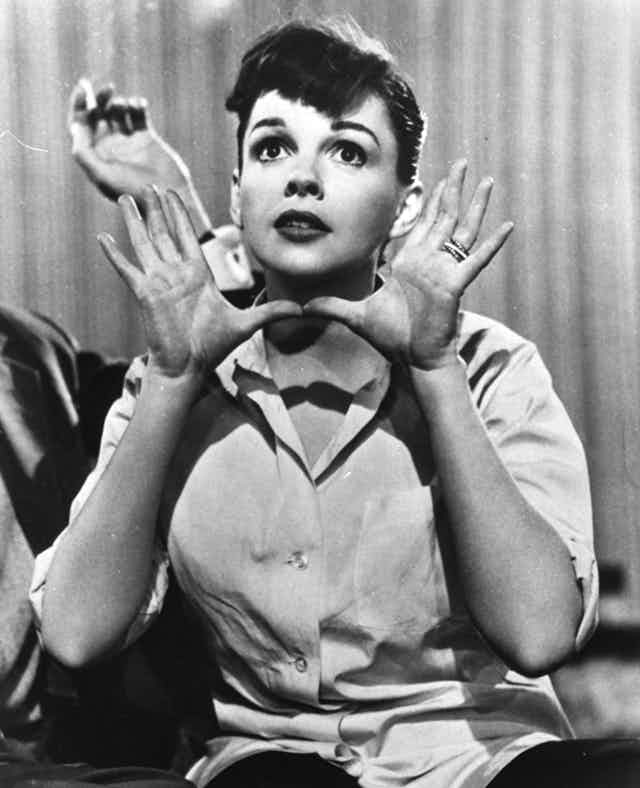There are many angles from which we can celebrate Judy Garland’s 100th birthday on June 10.
We can see her as iconic interpreter of the Great American Songbook, mother of a showbiz dynasty, gay icon, a sad symbol of the excesses of Hollywood control or a classic movie star.
But one of the most interesting things about her is not her place as the star of individual movies, or as a persona, but as a co-creator of a specific style of movie musical.
When looking at Garland’s varied filmography, I am struck by how many “integrated” musicals she starred in. These are movies where the songs contribute to telling the story as opposed to being simply attractive diversions: the songs are integrated into the plot.
Somewhere Over the Rainbow is specific to the plot of The Wizard of Oz (1939). No other character could sing it, and Dorothy could only sing it when she does, early in the film before her journey to Oz.
Similarly, The Boy Next Door in Meet Me In St Louis (1944) only fits where it is in the film: an expression of the wonder of a new crush.
Music for music’s sake
The earliest movie musicals of the late 1920s were either adaptations of preexisting stage shows, or backstage dramas about the staging of musicals replete with elaborate production numbers that have nothing to do with the plot.
The most famous among these were from Warner Bros with numbers staged by Busby Berkeley.
Read more: Unpacking In The Heights' choreographic film references, from Busby Berkeley to West Side Story
As the genre developed in the 1930s, there was usually a mix of plot numbers and pure spectacle, such as in the Fred Astaire/Ginger Rogers musicals made by RKO.
A few of Garland’s musicals fit this style, but most of the best known ones are strikingly void of musical numbers that exist purely for their own sake.
The makers of films like The Wizard of Oz, Meet Me in St Louis and The Pirate (1948) seem to have responded to Garland’s particular acting talents, writing stories and music that suited her storytelling style.
In this, she had an influence on both the form and the content of the film musical genre.
Even in her backstage musicals – where songs usually happen as performance, as opposed to being in musically-enhanced reality mode – Garland’s songs have double meanings as both performances and as character milestones.
The most famous example from Garland’s later career is undoubtedly The Man That Got Away from A Star is Born (1954).
In the film, Garland’s character Esther is rehearsing with her band, but it is clear the character is feeling the specific meaning of the song composed by Harold Arlen and Ira Gershwin for Garland to sing in this film.
A fully rounded character
Take one of Garland’s less familiar films, 1943’s Girl Crazy.
This is not a great film by any means, but it has a stack of classic Gershwin songs and the most interesting plot of Garland’s pre-Meet Me In St Louis films (other than The Wizard of Oz, of course).
Garland plays the postmistress of a small college town somewhere in the American West, to which Mickey Rooney’s character has been banished for having too much non-academic fun at Yale.
Each of Garland’s numbers shows off a different side of her talent while still allowing her to stay entirely in character.
Her comedy duet with Rooney, Could You Use Me?, is a masterclass in under-acting. Even though Rooney is hamming it up at his usual 110%, Garland gives hyperactive Rooney a run for his money by keeping quite still. Focus remains on her even during Rooney’s verses.
In Embraceable You, Garland has fun charming the entire student body of the men’s college where her grandfather is dean. She also shows off her dancing talents in the number.
The melancholic ballad But Not For Me is Garland in her miserable mode, but numbers like this (there is one in almost every Garland musical) never come across as cloying or full of self-pity.
Instead, the subtlety of her portrayal of heartbreak means the audience’s hearts break right along with hers.
Finally, I Got Rhythm shows how powerful she was as an anchor for a huge production number, here a five-minute extravaganza complete with singers, dancers and Tommy Dorsey’s big band, brought to the college to celebrate the fact that it is staying open (and will now be coeducational!).
Unlike many such production numbers, which exist only to show off the performers, this serves as a fitting climax to the film: Garland has found her man, and who indeed could ask for anything more?
That even a relatively minor movie such as Girl Crazy lets Garland play a fully rounded character through her singing demonstrates her influence as a singing actress.
Her considerable talents pushed her collaborators to give her their best work, integrating song and story and pushing the movie musical genre to greater sophistication.
Read more: Why Dorothy's red shoes deserve their status as gay icons, even in changing times
Correction: an earlier version of this story misnamed the lyricist for A Star Is Born. The writer was Ira Gershwin.

